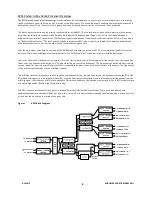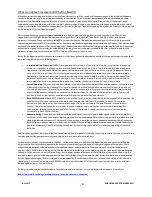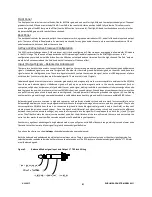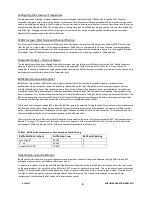
8/22/2017
SUBLIME ACOUSTIC MODEL K231
3
What is an Active Crossover and Why Do I Need It?
All speaker systems employ an electronic circuit called a crossover to split the sound into frequency ranges; it sends the low frequency
sounds to the woofer, and the high frequency sounds to the tweeter. This is important because each of the loudspeakers is built to
produce certain frequency ranges, and they don’t sound very good, or may even be damaged, if run outside of their proper range.
Loudspeakers can actually distort within their natural frequency range if they are also presented with frequencies outside their natural
range. In other words if you send low frequencies to your tweeter, the high frequency sound reproduced by the tweeter will be distorted
by the presence of the low frequency signal.
Most speaker boxes you see employ
passive crossovers
, which are made up of large inductors and capacitors that filter the low
frequencies from the highs. But passive crossovers have a number of very significant drawbacks. One big problem with passive
crossovers is they don’t have a very sharp
roll-off
. This means that some of the bass frequency energy will still reach the tweeter, and
some of the treble energy will still reach the woofer. Another major disadvantage with passive crossovers is efficiency; they waste a huge
amount of the power you’re amplifier is providing. High frequency sounds are prevented from going to the woofer (and low frequencies
prevented from going to the tweeter) by essentially just shorting them out; so power is wasted in the form of heat dissipated in the
crossover components. In some cases up to 50% of the amplifier’s power is lost to heat.
But by far the biggest problem with passive crossovers is that they significantly degrade the quality of the signals that pass through them
by introducing distortion in the following ways:
•
Intermodulation Distortion (IMD)
: Intermodulation distortion is a type of distortion that occurs when the passive
crossover is tasked with producing two or more frequencies at the same time. The intermodulation between each
frequency will produce additional frequencies at the harmonics and at the sums of the original frequencies that are
not part of the original signal. This is most pronounced when simultaneously reproducing very low and very high
frequencies. This type of distortion leads to a muddying of the sound created, making it harder to distinguish the
individual instruments across the sound stage. Active bi-amp’d or tri-amp’d systems are much less susceptible to
intermodulation distortion because the woofer and tweeter channels are driven by separate amplifiers.
•
Loss of Damping:
The caps and inductors placed in the circuit between the amplifier and the speaker coil cause a loss
of damping, meaning that the amplifier is more isolated from the driver and has weaker control over the motion of
the loudspeaker cones. The result is a muddier, less precise sound. In a bi-amp system the amplifiers are connected
directly to the speaker coils with no capacitors or inductors to get in the way of the amplifier’s ability to precisely
position the cones, which gives you dramatically higher sound definition and vibrancy.
•
Back-EMF Distortion:
Back EMF, or back electro-motive force, is the voltage created by the speaker winding when the
momentum of the cone causes the winding to continue moving relative to the speaker magnet. This voltage,
particularly from the woofer, flows backward through the crossover toward the amplifier and into the tweeter
channel. The massively chaotic interactions these voltages can cause are far too complicated to even begin to
calculate. But they do cause a great deal of distortion of the sound. Active bi-amp systems are not in any way
susceptible to back EMF distortion.
•
Channel phasing:
Once a passive crossover splits the audio signal, the woofer and tweeter signals can be out of phase from
each other (which means one leads or lags the other) due to loose component tolerances or temperature related variations in
these large discrete components. This causes distortion at and around the crossover frequency because at these frequencies
both the tweeter and the woofer will be driven, but each will be in a different phase. At various points of time in the wave the
woofer and tweeter will be either fighting one another or re-enforcing one another. This leads to a muddying of the sound
definition.
All of this adds significant distortion to the final sound created. Audio engineers for decades have tried in vain to come up with ever more
complex passive filter arrangements to try and resolve, or mask, these inherent problems.
A
ctive crossover
circuits,
like those used in the K231
, on the other hand, are built from the highest quality operational amplifiers (op-
amps) and the filter functions are applied to the line-level preamp input signals instead of the high voltage amplifier outputs. These
active filters are designed to be many orders of magnitude cleaner and more precise than the passives. Active filters have a much
sharper roll-off, 24dB/octave, allowing each of the loudspeakers to perfectly focus on producing only the frequencies they are designed
to handle. Active crossovers are also more efficient from a power standpoint because of the fact that the filters are applied in the line-
level audio input signal; only the energy meant for a particular driver is sent to the amplifier that drives it, so there is no wasted energy.
But the biggest advantage of active crossovers is the sound quality. A vanishingly small amount of noise and distortion is introduced in
the op-amp filter circuits, on the order of 0.00005% total harmonic distortion. All of this results in extremely clean, precise, and well
defined audio output to your amplifiers.
To learn more about the many advantages of active crossovers over passive crossovers, please read our paper on the subject:
https://www.xkitz.com/blogs/making-the-case-for-active-crossovers-vs-passive
Содержание K231
Страница 6: ...8 22 2017 SUBLIME ACOUSTIC MODEL K231 6...









